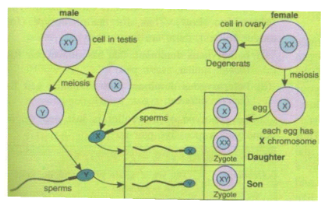Genetics
Exercise 1
Solution A.1.
d) Ascaris
Solution A.2.
a) 3 : 1
Solution B.1.
(a) – (iii) Study of laws of inheritance of characters
(b) – (v) Chromosomes other than the pair of sex chromosomes
(c) – (iv) A gene that can express when only in a similar pair
(d) – (ii) The alternative forms of a gene
(e) – (i) Chromosomes similar in size and shape
Solution B.2.
Lion, tiger, domestic cat (Any two)
Solution B.3.
Colour-blindness, Thalassaemia, Sickle cell anaemia and Haemophilia (Any two)
Solution B.4.
Homozygous dominant – RR
Homozygous recessive – rr
Solution C.1.
(a)
| Phenotype | Genotype |
| The observable Characteristic which is genetically controlled is called phenotype. | The set of genes present in the cells of an organism is called its genotype. |
(b)
| Character | Trait |
| Any heritable feature is called a character. | The alternative form of a character is called trait. |
(c)
| Monohybrid cross | Dihybrid cross |
| It is a cross between two pure breeding parent organisms with different varieties taking into consideration the alternative trait of only one character. | It is a cross between two pure breeding parent organisms with different varieties taking into consideration the alternative trait of two characters. |
Solution C.2.
The characteristics of a species such as physical appearance, body
functions and behavior are not only the outcome of chromosome number,
but these depend on the genotype of every organism. That means the set
of genes present in the organisms may very and therefore lion, tiger and
domestic cat have the same number of 38 chromosomes, their
characteristics (like different appearances) are the result of the genes
located on the chromosomes.
Solution C.3.
| Character | Dominant trait | Recessive trait |
| Flower Colour | Purple | White |
| Seed Colour | Yellow | Green |
| Seed Shape | Round | Wrinkled |
| Pod Shape | Inflated | Constricted |
| Flower Position | Axial | Terminal |
(Any 3)
Solution C.4.
- Colour-blindness is caused due to recessive genes which occur on the X chromosome.
- Males have only one X chromosome. If there is recessive gene present on X chromosome, then the male will suffer from colour-blindness.
- Females have two X chromosomes. It is highly impossible that both the X chromosomes carry abnormal gene. Hence, if one gene is abnormal and since it is recessive, its expression will be masked by the normal gene present on the other X chromosome. Females are unlikely to suffer from colour-blindness.
Solution C.5.
Phenotypic Ratio – 3 (Black Fur) :1 (Brown Fur)
Genotypic Ratio – 1(Homozygous Black Fur):2 (Heterozygous Black Fur): 1 (Homozygous Brown Fur)
Solution D.1.
(a) Heterozygous: The condition in which a pair of homologous chromosomes carries dissimilar alleles for a particular character.
For example –
- A daughter (XXo) from a normal homozygous mother for colour vision (XX) and a colour blind father has one normal and one defective allele (XoY).
- Certain tongue rollers are heterozygous with Rr genotype.
(b) Homozygous: The condition in which a pair of homologous chromosomes carries similar alleles for a particular character.
For example –
- A colorblind daughter (XoXo) will have both the X chromosomes with defective alleles.
- A non-roller will have rr (homozygous) genotype.
(c) Pedigree Chart: A pedigree chart is a diagram that shows the occurrence and appearance or phenotypes of a particular gene or organism and its ancestors from one generation to the next. In the pedigree chart, males are shown by squares and females by circles.
Solution D.2.
Mendel’s laws of inheritance are:
- Law of Dominance: Out of a pair of contrasting characters present together, only one is able to express itself while the other remains suppressed. The one that expresses is the dominant character and the one that is unexpressed is the recessive one.
- Law of Segregation : The two members of a pair of factors separate during the formation of gametes. The gametes combine together by random fusion at the time of zygote formation. This law is also known as ‘law of purity of gametes’.
- Law of Independent Assortment: When there are two pairs of contrasting characters, the distribution of the members of one pair into the gametes is independent of the distribution of the other pair.
Solution D.3.
-
- The sex of the child depends on the father. The egg contains only one X chromosome, but half of the sperms contain X-chromosome whereas the other half contains Y-chromosome. It is simply a matter of chance as to which category of sperm fuses with the ovum and this determines whether the child will be male or female.
- If the egg fuses with X-bearing sperm, the resulting combination is XX and the resulting child is female.
- If the egg fuses with Y-bearing sperm, the resulting combination is XY and the resulting child is male.

Solution E.1.

Solution E.2.
(a) Black
(b) No
Solution E.3.

Solution E.4.
(a) Father
(b) Two sons and three daughters
(c) The child 1 (daughter) is colour blind
(d) X chromosome
(e) Haemophilia
| Monohybrid cross | Dihybrid cross |
| It is a cross between two pure breeding parent organisms with different varieties taking into consideration the alternative trait of only one character. | It is a cross between two pure breeding parent organisms with different varieties taking into consideration the alternative trait of two characters. |
Comments
Post a Comment